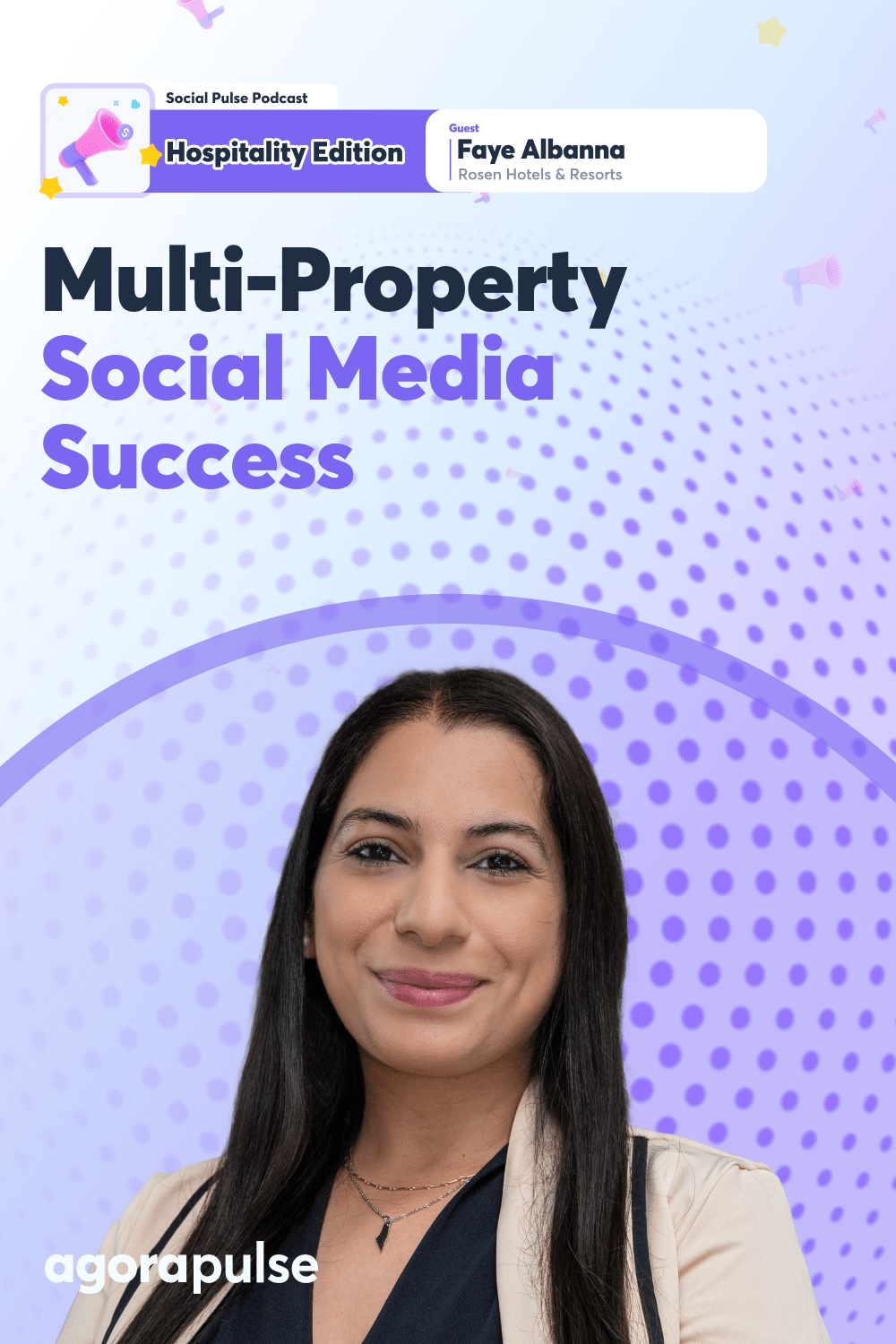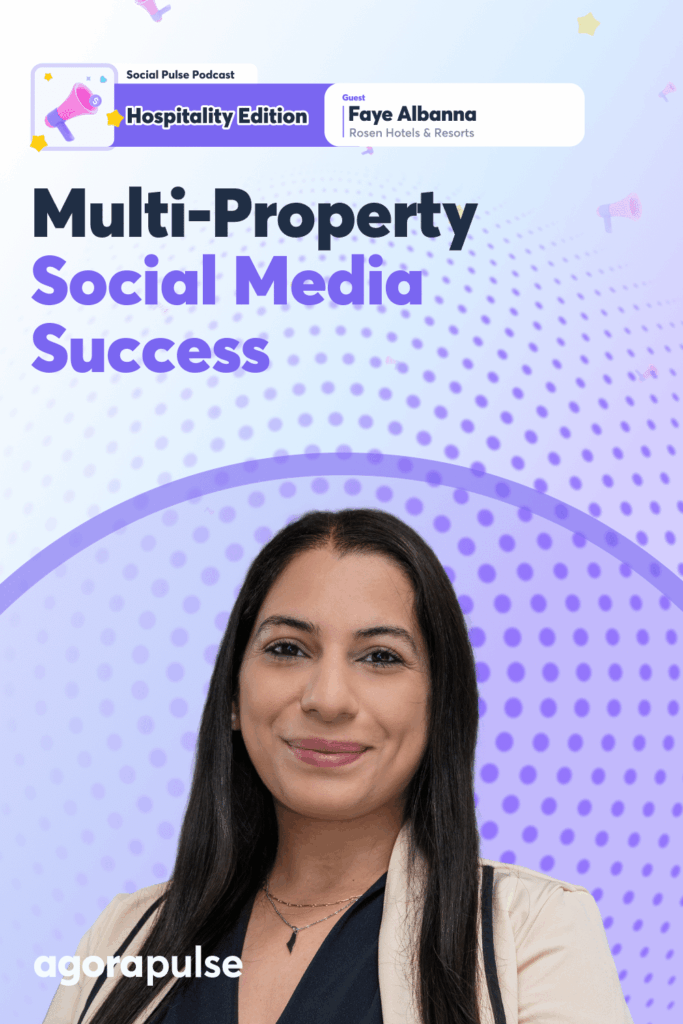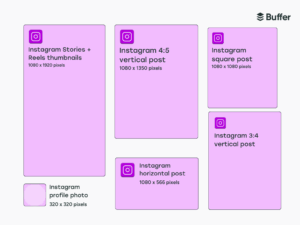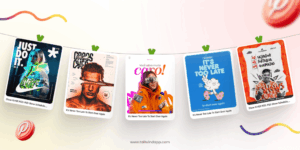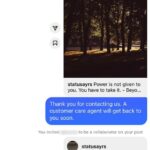What happens when your responsibilities multiply across not just two or three? But how about seven distinct hotel properties? The complexity increases exponentially.
In this recap of Social Pulse: Hospitality Edition, powered by Agorapulse, guest Faye Albanna knows those challenges intimately and has developed a framework that works. Faye transitioned from education to become the social media manager at Rosen Hotels and Resorts, where she oversees social media for seven distinct properties while managing a team of 13 associates.
[Listen to the full episode below, or read along for the transcript of the Social Pulse: Hospitality Edition, powered by Agorapulse. Try it for free today.]
Give us a snapshot of the scope of what you manage
Faye Albanna: So here at Rosen Hotels and Resorts, we’re based in Orlando, Florida, and we have seven hotels, which are all in Orlando, in the tourist district, and Mr. Harris Rosen—our former CEO and founder of Rosen Hotels and Resorts—is also very passionate in giving back to the community.
So, on top of our seven hotels, we also have a Rosen Aquatic and Fitness Center, which was formerly the YMCA. And we also have two preschools in underserved communities in the Orlando area.
So on top of seven hotels, we also cover the social media for the two preschools and the aquatic and fitness center. So I have a large team, as you mentioned, where each of the individual hotels, our corporate page, and our aquatic and fitness center page have their own Instagram and Facebook pages. Now with our preschools, we also use a Facebook page of Rosen Gives Back, where we feature some of those content pieces.
So, to answer your question, the volume is quite high. We have a formula here at Rosen where we do about four to five static posts, two reels per page, per account, and, of course, having a mixture of six to 12 stories going out seven days a week. So we have a high volume here at Rosen Hotels and Resorts, and we’re very proud of that.
Faye Albanna: Yes. So there’s more than one, but I’ll stick to one. I guess my biggest “oh no” was the type of content that was being pushed out on social media.
Social media is still an ever-changing industry. For some people, they just think it’s just a simple photo. But what we have to realize is just like how Reels became a new feature, and for most people, and I think other managers would agree that Reels are the best way to get out there, outside of our current audience. So, when I first came on board, I would reach out to some of the properties and say, “Okay, we’re going to promote some of the new F&B menu items.” And I was told we have some of those photos in the repository. So then I went to the vault repository of our content, and there it was, I would say content from 2007, 2009 (and I started in 2021), and I was like, “We cannot use that on social media!”
So, for me, that was probably my biggest “oh no”: if we have to take high-quality content, use our current iPhones at the time, and Sony, and just up our quality game with our content. So that was probably my biggest, oh no, this has to change here, it’s not recycling old content.
Mike Allton: No, that makes complete sense.
I know for a lot of brands, recycling content makes a lot of sense, but when you’re in this industry, in the location that you’re in, it’s probably not too many reasons to recycle content. Like you said, all you have to do is walk outside with an iPhone, and you’re creating wonderful content for social media.
Faye Albanna: Hundred percent. And to compete with our other competitors or even the newer concepts, like I said, across the street from us, we have to make sure that we not only blend in quality-wise, but also stand out in our own way.
Reusing old content does nothing for us. And honestly, we all know that apps compress that quality if you’re not up to the standard that they require. So that was a big change, and I’m happy to say that once I explained that everything was great and everyone was on board, we completely deleted the library and started a whole new library of our content.
How are you keeping everything straight without duplicating efforts or missing opportunities?
Faye Albanna: So we use OneDrive here at Rosen, and that has helped us so much because what I do is within our social media drive, I have a yearly drive. So I have a 2025 drive, for example, and within that, I have every property title. So, as Mr. Rosen opened each hotel, he named it R one, R two, all the way to R seven.
That’s how we identify our properties internally. So I have a folder for R one, and then within that, it dissects into the hotel elements of food and beverage, and then that dissects into outlet names.
So when I tell you it’s organized, it’s almost like when you have a Pinterest board and you think just putting food is okay, but then you go into more depth with titles. That’s how we have our content organized. But the team has a process where once we upload it to our computer, we only drop in the edited content. So we filter out the 200 pictures we took at Universal, and what, core 40, are we going to use and replenish that? So that’s part of our training process when we have new hires. So that’s what keeps us organized.
And then with Agorapulse, which we use to schedule our content. It’s easy for us to just upload from our shared drive because it’s edited, it’s ready to go, and we go from there. So that’s how we organize that. And, of course, the same thing with our Reels content. We have specific albums on our iPhone that we use for hotel elements. So it’s easy for us or my coordinators, when they’re doing any Reels and editing on their phones, they just go straight to the album, find the food and beverage outlet, they’re doing a con, a content piece on, and everything’s edited and ready to go in their albums. So we all know, and I say this with a laugh because I think everyone’s social media knows there’s a million tabs, a million albums, and it’s so right about that. But I always say this and stress it in my interview process as well.
Organization is so important. I actually asked that in an interview: How do you stay organized? How do you stay on top of deadlines?
Because social media is like handing someone a bin of small Lego pieces, and you have to rebuild every day, and there are so many moving parts. So organization is key, and that’s how my team stays organized.
How are you juggling their distinct brand voices?
Faye Albanna: So I’m very fortunate to have established very strong relationships with each of the properties. We are fully on site, so we go to the properties on a daily, weekly basis. And having this relationship with the general manager, the assistant general manager, the food and beverage director of sales and marketing that has helped form my team’s mentality of like-mindset: How do we represent the brand? Through their eyes because we’re in an ops building, operations building, and we just visit. But they know the clients, they know our guests, they understand what they’re selling in sales. They understand how to get on these site visits, how to get these big meeting groups to come here, and how to have a consistent brand voice.
So, being involved with the hotel team has helped with that consistency. And honestly, even though we’re, like you said, all under the Rose umbrella, we all have different brand aesthetics. Each hotel has different offerings. I will say of our seven, four of them are what we call our leisure properties. They’re more of our affordable hotels. They have similar branding, so that helps. But they all have a different story to tell, and they all have different elements to offer our guests and amenities. And three of the four of those in the properties of leisure are universal hotel partners. Whereas one that’s closer to Disney is a Disney-friendly neighbor hotel.
So, even though they might have similar looks and branding, they still have different offerings that we have to like to hone in on and represent that on our social media presence. So I think having that relationship and consistent communication is how we stay consistent.
How have you organized this team to manage all this complexity? Are there any roles that have proven particularly essential?
Faye Albanna: Yes. So I’m not sure if I mentioned this to you, but when I first started, there were only three coordinators in 2021, and we’ve tripled that almost quadrupled.
So, for me, what’s been essential is, I think once we started getting more of our higher executives and our hotel management teams, seeing the value of our social media presence and just testing the waters with like certain properties when I first got here, I started seeing and hearing a lot of, “Ooh, what’s going on over there? Oh, I would love for you to do that to my property.” So, that demand started happening. And with that came a lot more people’s buy-ins. That helped us get more people on board because once we heard that I want this property or my page to have more of a stronger presence, I’m like, “I need more people to do that.”
So that’s how we expanded that: the coordinator role. And then one day, my vice president asked me, “What would you do with a blogger?” And I said, “A blogger. Usually, the creative team works on that for the website. Let me think.” So I got back to her and I said, “What if I have a vlogger?” And she said, “Go on.” And so I said, “Think of it as our own influencer in-house or our travel host. So who’s constantly, like everyone in the audience recognizes this person, versus just having voiceovers. They know her face, they understand who she is, and everyone looks forward to seeing this face.
Mr. Rosen’s always been the face of the company, but on a social standpoint, someone who’s like getting everyone excited to come to Epic or stay at our properties.”
So she said, “OK, put something together.” So I put a job description, I storyboarded some samples, and we went for it, and we got it approved.
And here we are, about a year and a half later, with the role being so successful. And so to me, that’s something that I am very proud of because no other hotel or any other company in Orlando has their own vlogger. Sure. We also still partner with influencers and whatnot, but we’ve created this role, and no one else is doing that right now. So, to me, that’s been an essential piece. And it’s interesting because when we do our analytic reports every month and monthly and quarterly, and semi-annually, when we do our best, Agorapulse is great for this. You do the best-performing posts right for the month, and they show the top six.
Two to three every month have been vlogs. And that’s been a great way to show the ROI and prove this is why people are booking. They’re even telling and talking to her, saying, “Hey Amber, love this. Can you do a video on this?” Which has triggered more content ideas. So I know I went further to answer your question, but all roles have been so essential, but it’s been wonderful to see the growth, and now more people want a piece of the cake, if you will.
What systems have you put in place to ensure that you’re capturing fresh content for all these properties all the time?
Faye Albanna: So, I have a feeling most people might say, “Wow, that’s pretty impressive that you don’t repeat content.”
But I take content very seriously, where I am a firm believer in getting fresh content. And if I recycle a piece of content, it might be used in a story versus like on the grid repeatedly. So, for me, like I mentioned earlier, we have a four to five static post expectation in Reels. Our Reels are never repurposed, which we can look at one day, maybe saying, “Okay, it’s been about a year, let’s bring it back, especially if it was successful.” But right now, our expectation is to have our Reels be something new and fresh, especially with what’s new and out there.
For example, with Epic opening up in a month from next week, we are working on Epic content, doing a countdown one month away. So that’s not something we might do again in a few months. So that’s something that we’re constantly trying to change and stay up to speed with trends. And what’s trendy currently? Same with static posts. I think social media is constantly ever changing, and what’s popular one day is not popular the next year, but carousels are back to being popular.
When we’re doing something for Earth Day coming up, we have so much content, and I always tell the team the properties might not change, but how we present the content and the property should change. So we try to put in different subjects in the photos and maybe different angles that we haven’t done before, using different props.
So, it is challenging, I will say, to constantly have new content of properties that might not have new features, a new pool, a new thing, but how we place items in front of it, whether it’s a suitcase or a model. And this, a room key, which, if you scroll through a page, you will see as well. Those are our ways of making new content look different. But I am a stickler about it, it has to be fresh and different.
Are you also using those same [vertical video] posts on multiple channels, or are you creating new content for each channel?
Faye Albanna: That’s a great question. So we’ve always done the Reels on Instagram. Last year tested it out to see where the Reels weren’t performing as high on Facebook for our convention properties as they were the leisure properties. We’ve been consistent with posting Reels on both platforms for four of the seven leisure properties.
But this year we’re like, “Let’s take a different approach on it. Let’s listen to what our audience is saying on Facebook.” And we also have a three-status update formula on Facebook. And so we actually decided one day, it was like, “You know what? Let’s just ask them what kind of content they want to see on Facebook. What video tours do they want to see?”
Once we started doing that and listening to the audience, we’re like, “Oh, maybe they’ll watch the videos if we do what they want,” which obviously within brand guidelines and what our goals and mission and objectives and KPI goals were, so once we started honing in on that’s when the video Reels started performing well and having that engagement on the convention.
So we have differentiated the content, but one thing we notice is that anything informative and safe, something they want to save as bookmarks. That’s been consistent across both platforms. But what we also post on our TikTok is that we only have one corporate handle on TikTok and one on Threads. That content is completely different from Facebook and Instagram. Sometimes we might sprinkle our successful reels on Instagram that can be like. Go. I always say, “Can you join the stream, or are you standing? You’re getting pushed to the rocks, like how is it going to go when we post it on TikTok?”
And for us, our TikTok is completely different because it’s a little bit more on the edgy side. And you’re doing like the fun trends and all that, but my team also knows we have to stick within what our branding is. Is this something that is going to jeopardize our reputation as a brand, so we have to be cautious about that?
But it’s definitely more about living on the edge of our content.
Faye Albanna: Yeah, so of course we love using Agorapulse for many of its tools and social listening. I know I haven’t hit on that, but that’s been a huge tool from Agorapulse that we’ve used and has helped us not only engage and get new potential followers because they’re like, oh, you see me talking about you and then we start engaging with them, but also for content ideas.
So for me, Agorapulse has so many tools. And then we also use Microsoft Planner for our organization and for our tasks. That’s something that my team uses heavily. We also use Microsoft Forms. That’s actually how my team submits their Reel ideas to me every Friday. We have a system in place where they talk in depth about what their vision is, what tools they need, who they’re communicating with at the hotels, and I approve that. And then they execute it the next week and a half. So we have a lot of systems and tools in place. We also like to use Canva a lot. We use Adobe products. All of those programs help us with our workflow.
Tell me about that Reel process a little bit more.
Mike Allton: So on Friday, your associates have to have an idea of how many ideas they have to send.
Faye Albanna: Two ideas.
We have a 10:00 AM deadline on Friday morning for it to be submitted. Okay. And then I usually have it sent back to them within the next couple of hours. That way, they could start filming. And so let’s say it’s approved or tweaked on Friday, have that discussion. They have technically Friday afternoon until the following Thursday to film, edit, and all of that. And then they have it drafted with the caption, with the tags, everything.
And then on Thursday is where I call it my Reel approval day, and I approve it, but it doesn’t get posted to the following week. So it’s like a two-week ahead process, but I found it more helpful. It’s their storyboard, if you will. And it helps me also do the research of opening up their current page and seeing, okay, you did a food and beverage Reel on this day.
There’s at least two weeks of a gap until you hit it again. So there’s not too much repeating happening. And then we also, like I said, look at what’s happening now. Next week is a month away from Epic [Universe] opening, so we have so many things to look at, but this organized form helps me stay on top of the 30 videos that I’m approving every week.
How do you measure the actual business impact of all this across all these social profiles of multiple properties?
Faye Albanna: That’s a great question, and a question I get often is: How do I prove the ROI?
And I’m going to be honest, I’m still trying to figure it out because it’s not easy in an organic society to constantly prove that someone from our video just booked a stay at one of our properties now. We have tried, of course, different methods to try to prove that, which helps us.
So, for example, we have holiday buffets. So for Easter, we have four of the seven properties that have extravagant buffets that are wonderful. You should check it out. And so with that, when we promote it on social, we have unique links that our creative and web team has helped us create for tracking, “Okay, this many clicks came from Instagram, this many clicks came from Facebook.” So that has helped us with that part.
Now, also what we try to do is when we have a campaign running outside of the unique links, we might have okay, this is only a promo from social media. So we have a Teppanyaki restaurant where we had posted before on that hotel page, “This is a special for just social media, so if you show this host the hostess, you get this type of deal.” So those are other proven ways we’ve been trying to prove the ROI.
To this day, I still can’t find one person who could say, “This is exactly how many people came from social.”
When I’m challenged by that question, I also say it back, “How do you prove that this billboard or this article in this magazine brought people to our hotel?”
I think it’s also important to remember that having a strong social media presence is meant for brand awareness in hopes that we can have an ROI, and when we do (and we can prove it), it’s wonderful.
Thank all of you for reading the highlights of this episode with Faye Albanna. Don’t forget to find the Social Pulse Podcast: Hospitality Edition on Apple and drop us a review. We’d love to know what you think. Don’t miss other editions of the Social Pulse Podcast like the Retail Edition, Agency Edition, and B2B Edition.
